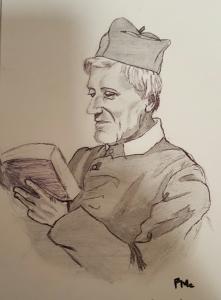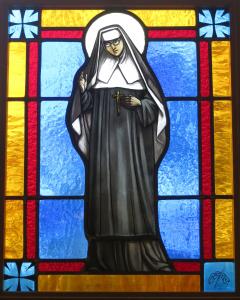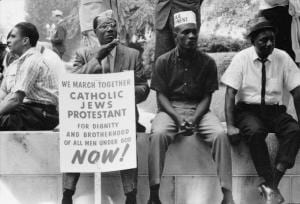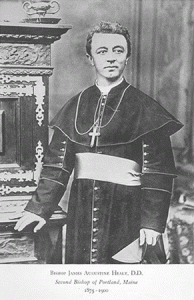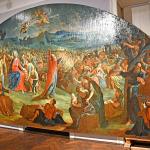This day in 1943 marks the death of Edward O’Rourke, the first Bishop of Danzig in Poland. The following is taken from Wikipedia:
O’Rourke was born October 26, 1876 in Basin, Minsk, Russian Empire (modern Belarus), to an aristocratic family of Irish ancestry, many of them high officers in the Russian military. They held imperial titles of the Russian Empire and of the German Holy Roman Empire, but also had petitioned to retain the Irish count title as well, which was granted by the Tsar in 1848. His father was Michael Graf O’Rourke and his mother Baltic-German Angelika von Bochwitz. He received a widespread European education and learned a number of languages.
After graduating from the famous Jesuit college in Chyrów (then Russia, now Ukraine), in 1898 he went to Riga, Latvia, where in 1903 he graduated from the Trade and Mechanics Faculty of the University of Riga. In 1903 he moved to Freiburg, Switzerland, where he continued his studies at the University of Fribourg, faculty of law, but the following year he moved to the theological faculty at the University of Innsbruck in Austria-Hungary.
After graduating from the famous Jesuit college in Chyrów (then Russia, now Ukraine), in 1898 he went to Riga, Latvia, where in 1903 he graduated from the Trade and Mechanics Faculty of the University of Riga. In 1903 he moved to Freiburg, Switzerland, where he continued his studies at the University of Fribourg, faculty of law, but the following year he moved to the theological faculty at the University of Innsbruck in Austria-Hungary.
On October 27, 1908 he was ordained a priest in Vilna (Vilnius, Lithuania) and became a professor of ecclesiastical history, German and French language at the Seminary of the Roman Catholic Archdiocese of Minsk-Mohilev in Saint Petersburg. Between 1912 and 1915 he became the priest of the multilingual congregation of St. Stanislaus in Petersburg[1]. After the February Revolution in Russia it was decided to re-establish the diocese of Minsk and O’Rourke was appointed as its administrator and the interim head of the Catholic Church in Russia. As such O’Rourke met for the first time the Apostolic Visitor for the Baltic countries, Achille Ratti, the later Pope Pius XI. Due to the proposed independence of Latvia the diocese of Riga was established in 1918 and O’Rourke was appointed the bishop of Riga on recommandation of Ratti on 29 September 1918.
O’Rourke’s position in Riga was problematic as he managed to assume his office only after German forces had occupied Riga in early 1919. At that time shortly after World War I the ecclesiastical organisation was largely destroyed and only a few priests were active. O’Rourke, who himself didn’t speak Latvian, tried to encourage Latvian priests but tendered his resignation after a new government in Latvia was appointed and calls for a Latvian bishop raised. O’Rourke was released as the bishop of Riga on 10 April 1920 and appointed the titular bishop of Canea and Apostolic Delegate for the Baltic states, in November 1921 also the Pontifical Delegate for Russian refugees in Danzig and East Prussia, later (1928) for the Russians in Germany.
The Free City of Danzig was split from Germany in 1920. On April 24, 1922 Achille Ratti, now Pope Pius XI, nominated O’Rourke to the post of an Apostolic Administrator of the Free City of Danzig and the titular bishop of Pergamon on 21 December 1922. After the creation of the Diocese of Danzig on December 30, 1925, O’Rourke became the first Bishop of Danzig. First having a good relationship with the authorities, who granted him citizenship on 12 June 1926, and the mostly Protestant population, he conflicted with the new local Nazis after 1933. Having hosted synode on 10 to 12 December 1935, growing pressure from the Nazi majority senate made him resign as bishop of Danzig after he had tried to implement four additional Polish parish priests[3]. On 13 June 1938 he was appointed Titular bishop of Sophene. He adopted Polish citizenship in December 1938 as well as the office of Cathedral Canon in Gniezno/Poznań. When the Germans attacked Poland in September 1939 O’Rourke was on a journey to Estonia and travelled via Warsaw and Königsberg to Berlin, where he applied for a Visa to Italy. After his arrival in Rome O’Rourke tried to return to his Diocese in Poznań, but his visa application was rejected by the Germans. O’Rourke died in Rome on June 27, 1943, his successor after his death was the Bishop of Danzig Carl Maria Splett. In 1972 his ashes were moved from Campo Verano to his former bishopric to be buried in a crypt in the Oliwa Cathedral.



